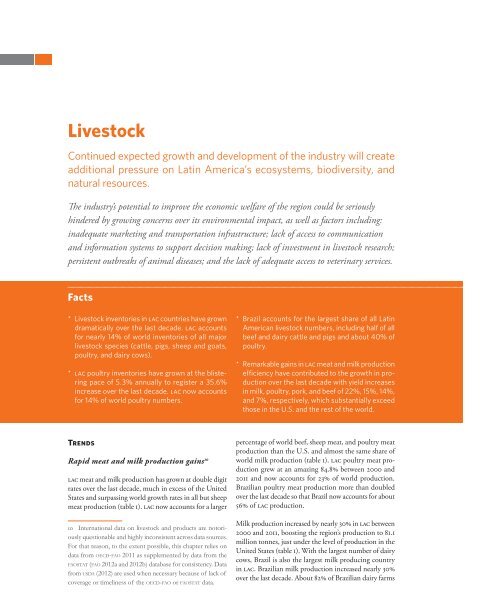1eVf8UD
1eVf8UD
1eVf8UD
Create successful ePaper yourself
Turn your PDF publications into a flip-book with our unique Google optimized e-Paper software.
Livestock<br />
Continued expected growth and development of the industry will create<br />
additional pressure on Latin America’s ecosystems, biodiversity, and<br />
natural resources.<br />
The industry’s potential to improve the economic welfare of the region could be seriously<br />
hindered by growing concerns over its environmental impact, as well as factors including:<br />
inadequate marketing and transportation infrastructure; lack of access to communication<br />
and information systems to support decision making; lack of investment in livestock research;<br />
persistent outbreaks of animal diseases; and the lack of adequate access to veterinary services.<br />
Facts<br />
* Livestock inventories in lac countries have grown<br />
dramatically over the last decade. lac accounts<br />
for nearly 14% of world inventories of all major<br />
livestock species (cattle, pigs, sheep and goats,<br />
poultry, and dairy cows).<br />
* lac poultry inventories have grown at the blistering<br />
pace of 5.3% annually to register a 35.6%<br />
increase over the last decade. lac now accounts<br />
for 14% of world poultry numbers.<br />
* Brazil accounts for the largest share of all Latin<br />
American livestock numbers, including half of all<br />
beef and dairy cattle and pigs and about 40% of<br />
poultry.<br />
* Remarkable gains in lac meat and milk production<br />
efficiency have contributed to the growth in production<br />
over the last decade with yield increases<br />
in milk, poultry, pork, and beef of 22%, 15%, 14%,<br />
and 7%, respectively, which substantially exceed<br />
those in the U.S. and the rest of the world.<br />
Trends<br />
Rapid meat and milk production gains 10<br />
lac meat and milk production has grown at double digit<br />
rates over the last decade, much in excess of the United<br />
States and surpassing world growth rates in all but sheep<br />
meat production (table 1). lac now accounts for a larger<br />
10 International data on livestock and products are notoriously<br />
questionable and highly inconsistent across data sources.<br />
For that reason, to the extent possible, this chapter relies on<br />
data from OECD-FAO 2011 as supplemented by data from the<br />
FAOSTAT (FAO 2012a and 2012b) database for consistency. Data<br />
from USDA (2012) are used when necessary because of lack of<br />
coverage or timeliness of the OECD-FAO or FAOSTAT data.<br />
percentage of world beef, sheep meat, and poultry meat<br />
production than the U.S. and almost the same share of<br />
world milk production (table 1). lac poultry meat production<br />
grew at an amazing 84.8% between 2000 and<br />
2011 and now accounts for 23% of world production.<br />
Brazilian poultry meat production more than doubled<br />
over the last decade so that Brazil now accounts for about<br />
56% of lac production.<br />
Milk production increased by nearly 30% in lac between<br />
2000 and 2011, boosting the region’s production to 81.1<br />
million tonnes, just under the level of production in the<br />
United States (table 1). With the largest number of dairy<br />
cows, Brazil is also the largest milk producing country<br />
in lac. Brazilian milk production increased nearly 30%<br />
over the last decade. About 82% of Brazilian dairy farms<br />
A Perspective on Latin America and the Caribbean<br />
53


